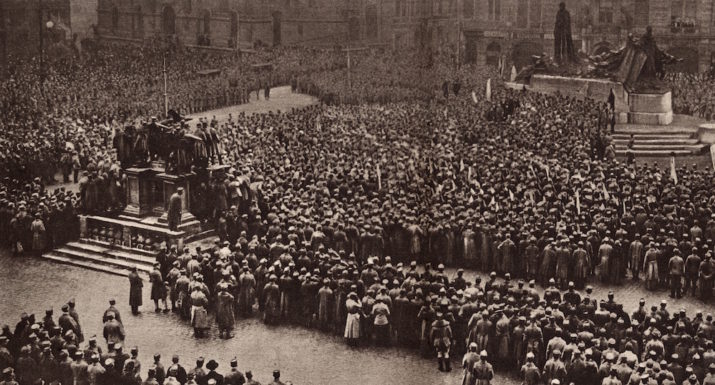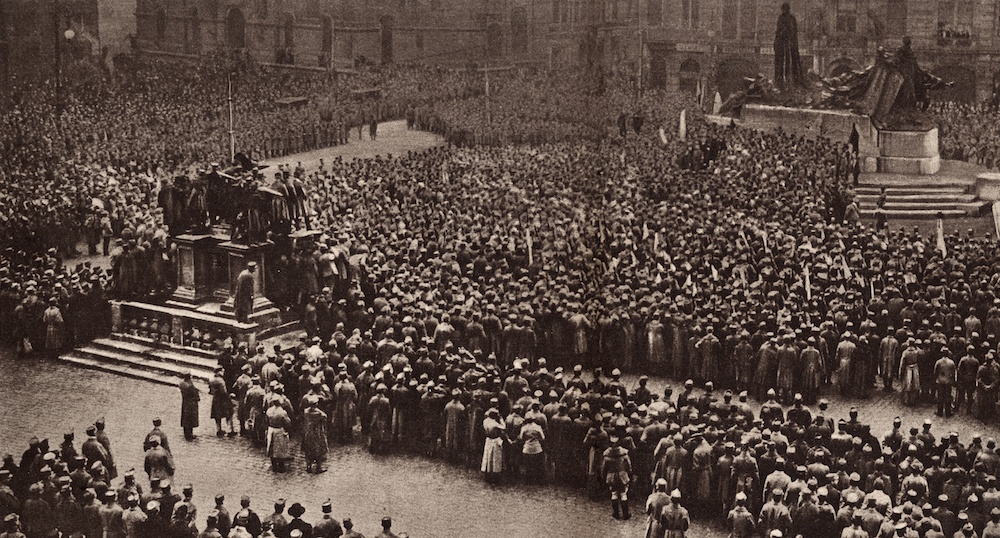

This is part of our special feature, Diversity, Security, Mobility: Challenges for Eastern Europe.
Discourses of securitization and its resulting political decisions are deeply rooted to a shared set of knowledge. The lack thereof may lead securitizing actors to different assessments or even substantial misinterpretations of certain subjects and contexts. To make the interrelation clear, this paper will present a striking example from the highly multicultural Interwar Czechoslovakia and, more precisely, from the securitization of Czechoslovakia’s “far east,” a province called “Subcarpathian Rus,”[1] and its particular minority situation. Two main factors complicated the then evolved dynamics of securitization. First, the importance of the factor “knowledge” (or the lack thereof): for the Czech elites in Prague as well as for the clerks, who took over the local administration, the Subcarpathian Rus was totally unknown.[2] That factor opened the door to all kinds of misinterpretations and false accusations—what we nowadays call “fake news.” Second, as a result of this ignorance, the local minorities and especially the Hungarian minority were securitized as a potential threat for the political stability in that region.[3]
On January 2, 1919, only a couple of months after World War I, the Czechoslovak government gathered at the Prague Castle to talk about the upcoming Peace Conference in Paris, which was about to start a month later.[4] The ministers passionately debated their negotiation strategy—one important aspect were the borders of the newly established Czechoslovak nation state. In fact, neither the members of this particular meeting nor the delegates of the Czechoslovak delegation in Paris could agree on the shape of Czechoslovakia—a state that was still in the making. The borderlands, some only recently annexed, were especially a matter of dynamic securitization.
In the late afternoon, even President Masaryk and other important figures of the Czech political elite joined the discussion. Rudolf Bechyně, a Social Democrat and leader of his party’s faction in the Czechoslovak parliament, wanted to know who the future neighboring states in the East of Czechoslovakia might become. Depending on the outcome of the conflicts in Eastern Galicia and the Russian Civil War, Czechoslovakia might have ended up sharing a border with Poland, Ukraine, or Russia. Bechyně mentioned this point because he was not only concerned about Czechoslovakia’s border in general, but about the local population of future potential borderlands. To quote his words, he worried about too many “alien elements” (cizí prvky) flooding into the country, gaining too much influence and destabilizing the new democracy.[5]
About 30 percent of Czechoslovakia’s population belonged to a national minority: Germans in the West, Hungarians in the South of Slovakia and the Subcarpathian Rus, Ruthenians in the Carpathian Highlands, Jews, Romanians, Poles, Roma. For the Subcarpathian Rus, the population census from 1921 showed the following results: Ruthenians: 62.98 percent, Magyars: 17.25 percent, Jews: 13.52 percent, Czechs & Slovaks: 3.33 percent.[6]
Bechyně questioned the attachment of the Subcarpathian Rus, because—as it seemed in the census—it was inhabited by “alien elements” only. This was the first time that the Subcarpathian Rus was ever mentioned in a meeting of the Czechoslovak government, and it was used immediately to articulate security issues. In the course of the debate, it became clear that better-informed descriptions of the Subcarpathian Rus were necessary. For the Czechs at the Prague Castle, it was all new and everything unclear.
The Subcarpathian Rus is still a region for specialists. For hundreds of years, together with Slovakia, the territory of later Subcarpathian Rus embodied the northeastern part of the Kingdom of Hungary. Until 1918, it was the neighboring region to Habsburg Galicia, and in the Interwar Period, it formed Czechoslovakia’s eastern borderland to the reestablished Polish state. The population consisted of an East Slavic—Ruthenian—majority, large Hungarian and Jewish minorities, as well as Romanians and Roma. Until 1918, as the titular nation, the Hungarians constituted the dominant group, and contrary to for example Slovaks and Romanians, the Ruthenians of Hungary did not develop their own local nationalist movement.[7]
This phenomenon can be explained as follows: At the end of the First World War, most Ruthenians were uneducated. They had basically no political representation. The few educated Ruthenians usually identified with the dominant group: the Hungarian nation. Paul Robert Magocsi already remarked that “only a hand full of conscious patriots identified with a Slavic heritage.”[8] In fact, the vast majority of the Slavic population had a Christian identity, not a national one. In the words of Tara Zahra and Pieter Judson, these people were “nationally indifferent.”[9] In nationalistic terms, they were not “nationally conscious” or “not awakened” yet.
Following the end of World War I, the political development in and around the Ruthenian part of Hungary was quite dramatic and complicated. As a result of certain events in Hungary, East Galicia, and Russia, the Ruthenian territory was assigned to the new state of Czechs and Slovaks.[10] But building proper state structures in that area was a difficult task. Hungarians, as the former dominant group, were not trusted, and due to the lack of educated locals, Czech state officials were sent from the capital to the far away province to build up the new administration. Unfortunately—as I already mentioned—these officials had nearly no prior knowledge about the region. For them, the Subcarpathian Rus was a terra incognita. The only thing they seemed to “know” was that the Hungarians and large parts of the Jewish population were not reliable partners. They suspected them to support revisionist or communist movements.
The Czech administration in Prague and Uzhhorod—the capital of the Subcarpathian Rus—lacked any knowledge about the region and its local languages. The need to gather information and survey the land and the people to create new, useful knowledge was evident to everyone. Self-declared and real “experts” were called and some of them received permanent positions in the public administration.[11] Due to the lack of knowledge, state officials were extraordinarily sensitive towards news about potential security threats in the Subcarpathian Rus. They often failed to comprehend information about security issues, because they analyzed them according to what they knew from their home base, the Bohemian Lands, so, nowadays Czech Republic.
The Czechoslovak army was based on a conscription system, but during the early 1920s, the act of physical examination seemed to become a floor for nationalistic agitation. When German and Czech recruits arrived drunk at physical examinations, the whole event often ended in physical violence. Nationalistic Czech media interpreted these events as anti-Czechoslovak agitation by the Germans. In fact, drinking alcohol before the physical examination was a habit from already Habsburg times, because joining the army was seen as an important step for a young man to become an adult.[12] On August 8, 1920, the liberal newspaper Tribuna from Prague reported that during physical examinations in Uzhhorod “bloody riots” had broken out. The rioting locals had used knives, sticks, and heavy stones. According to the report, eight recruits were seriously injured, and many more wounded. That was the scene according to Tribuna.[13]
The Ministry of Internal Affairs took note of this article and requested a report from the local administration in Uzhhorod. Here the securitization started. The Ministry feared an act of “antimilitaristic propaganda” and wanted to know if it was just a random, spontaneous incident or a case of passive resistance against recruitment. To get to the bottom of the story, the local administration corresponded with the responsible department in Uzhhorod. They declared that the physical examination had been conducted absolutely peacefully, except for one brawl between two drunken recruits. The brawl had broken out because they belonged to two different groups of recruits, which had provoked one another for the way they had dressed up that day. In fact there was no kind of agitation against the physical examination. The number of attending recruits was even higher than the responsible department had expected.[14]
In my view, this case is more than just a misinterpretation of local events far away from the capital Prague. The question is: Who was suspected to have committed the said act of “antimilitaristic propaganda?” According to the Czechoslovak census from 1920, 19.828 people lived in Uzhhorod. 25 percent of them were “Czechoslovaks,” so mostly Czech clerks with their families, 39 percent Hungarians and 19 percent Jews. Only 14 percent declared themselves members of the Ruthenian majority.[15] The “antimilitaristic” recruits most likely belonged to the Hungarian or Jewish minorities. As mentioned above, in the eyes of Prague, the Hungarians were considered a revisionist threat to the Czechoslovak state. So the Ministry of Internal Affairs interpreted the incident as a clash of Hungarian revisionist recruits with East Slavic or Czechoslovak recruits. In this case it was possible to clarify the incident quickly, but as I will show in the following and last example, the combination of a lack of knowledge and the fear of the Hungarian minority had serious political consequences.
Fear of the Hungarians
First of all, the government in Prague needed reliable partners in the Subcarpathian Rus. To that end, they favored the pro-Czechoslovak Ruthenian elites. After centuries of Hungarian domination, the Czechoslovak nation state tried to empower the Ruthenian majority to gain their loyalty. At the same time, the fear of the former Hungarian rulers was still present. The local elites as well as the Czech state representatives were aware of the long lasting loyalties among the local population towards their former Hungarian “lords.” To overcome this legacy, one step was to introduce the “Czechoslovak” and Ruthenian languages as official languages. The next step was to remove Hungarians from political and social positions of power, which was complicated by the lack of Ruthenian candidates to replace them. That is the reason why Hungarians were actually dismissed from only one sector of the state administration completely: the security sector. For all the other positions, it was possible for Hungarians to stay, if they swore their loyalty towards the Czechoslovak state.[16]
A key element in winning over “the hearts and minds” of the local population was political participation and the opportunity to define their own political fate. To do so, the people of the Subcarpathian Rus were to take part in the countrywide parliamentary election of spring 1920. The state officials in Prague were quite surprised when they received protest letters from the two most influential Ruthenian national councils shortly before the election. They requested to have the elections postponed for several reasons: First of all: the Ruthenians demanded full autonomy. Secondly, there were still no fixed borders, and thirdly, the infrastructure was bad.[17] But the state officials in Prague suspected another reason behind this request. They believed that the national councils feared losing their political power again, because the Hungarians might actually win the elections. In Prague they shared this fear and used it in public to justify the postponement of the elections in the Subcarpathian Rus. But another factor was important: unqualified Czech staff in the local administration without any deeper knowledge of the area and its people.
In November 1920, in a letter to the Ministry of Internal Affairs, the local administration explained their problems as follows: The offices were often occupied by “not fully qualified staff” with little practical experience. Especially in the eastern part of the Subcarpathian Rus, the notaries and clerks had only worked there for a short time and a lot of them did not know “the local language very well.”[18] However, the contemporary press did not blame the administration for the delay of the elections. Instead, they identified the whole territory of the Subcarpathian Rus as “backward” and such provincial backwardness as the reason for all the problems the Czechoslovak state had over there.[19] In June 1923, the lead of the League of Nations’ Minority Section, the Spanish Professor of Law Pablo de Azcarate, visited the Subcarpathian Rus. His department had received petitions complaining about the legal situation of the Hungarian minority. Azcarate was seriously concerned about why the parliamentary elections had not yet taken place in that region. The Office of the President of Czechoslovakia explained to him that it was because of the Hungarians who were still a too influential and too dangerous group in that area. Azcarate was satisfied with that explanation.[20] One year later, elections were held and with around 30 percent of the votes the winners were the Communists, not the Hungarian Parties who would never win a single election there.[21]
Again, Prague totally misinterpreted the conditions in the Subcarpathian Rus. They securitized the Hungarian minority as a potential threat to the political stability, used them as an excuse to postpone the badly prepared elections, hold back the right to vote for the people of a whole region and in the end totally underestimated the influential Communist party. Not even Czech “experts” in the Ministries were able to anticipate this very outcome of the election. For their “unknown borderland” they simply weren’t “expert” enough.
Sebastian Paul is an academic employee at the Herder Institute for Historical Research on East Central Europe – Institute of the Leibniz Association in Marburg. He studied Eastern European History and Public History at the Justus-Liebig University Giessen, the Masaryk University in Brno and the University of Pécs. Since 2014 he is a member of the DFG financed Collaborative Research Centre “Dynamics of Security”, which is located in Giessen and Marburg. In his PhD project, he examines the link between knowledge and politics by analyzing the security discourses on Czechoslovak Subcarpathian Rus (1918-1939).
Photo: The Prague Garrison swears allegiance to the new Czechoslovak Republic. Nov. 15, 1918. The state was founded in October 1918, at the end of World War I, by the Treaty of St. Germain, Everett Historical | Shutterstock
References:
[1] Paul Robert Magocsi, With their Backs to the Mountains: A History of Carpathian Rus’ and Carpatho-Rusyns, Budapest: Central European University Press, 2015.
[2] Viktor Budin, Podkarpatská Rus očima Čechů [The Podkarpatská Rus in the Eyes of the Czechs], Praha: Nakl. Česká expedice, 1996.
[3] On Hungarian revisionism in the Interwar Period, see: Anikó Kovács-Bertrand, Der ungarische Revisionismus nach dem Ersten Weltkrieg : der publizistische Kampf gegen den Friedensvertrag von Trianon (1918 – 1931), München: Oldenbourg, 1997; Miklós Zeidler, Ideas on territorial revision in Hungary : 1920 – 1945, New York: Columbia Univ. Press, 2007.
[4] The minutes of this meeting are published in: Československo na pařížské mírové konferenci 1918 – 1920: Vol. 1: Listopad 1918 – červen 1919, edited by Jindřich Dejmek, Praha: Ústav mezinárodních vztahů, 2001, 131-142.
[5] Ibd., 138.
[6] Statistisches Staatsamt, Statistisches Handbuch der Čechoslovakischen Republik II, Prag: Buchdruckerei Melantrich, 1925, 362-363.
[7] Ivan Žeguc, Die nationalpolitischen Bestrebungen der Karpato-Ruthenen, Wiesbaden: O. Harrassowitz, 1965.
[8] Paul Robert Magocsi, The Shaping of a National Identity: Subcarpathian Rus’, 1848 – 1948, Cambridge, MA: Harvard University Press, 1978, 74.
[9] Pieter M. Judson, Guardians of the Nation: Activists on the Language Frontiers of Imperial Austria. Cambridge, MA: Harvard University Press, 2006; Tara Zahra, “Imagined Noncommunities: National Indifference as a Category of Analysis.” Slavic Review 69, no. 1 (Spring 2010): 93-119.
[10] Paul Robert Magocsi, “The Ruthenian Decision to Unite with Czechoslovakia.” Slavic Review 34, no. 2 (1975): 360-381; Peter Švorc, “Začlenenie Podkarpatskej Rusi do ČSR (1918-1920). [The Integration of Podkarpatská Rus Into the ČSR (1918-1920)]” Česko-slovenská historická ročenka ročenka [Czecho-Slovak Historical Yearbook] (1997): 39-60; Sebastian Paul, “Zwischen Loyalität, Realpolitik und Bündnisoption. Die Angliederung der Podkarpatská Rus an die Tschechoslowakei, 1918-1919” In Akteure der Neuordnung. Ostmitteleuropa und das Erbe der Imperien, 1917-1924, edited by Tim Buchen, Frank Grelka. Berlin: epubli, 2017, 77-90.
[11] One example is the former engineer Jaromír Nečas (1888-1945), who became the leading advisor for the Subcarpathian Rus at the Office of the President of the Czechoslovak Republicin Prague. In 1936 he even became the Minister for Social Welfare.
[12] On the Czechoslovak army and its physical examinations in Czechoslovakia’s multi-ethnic borderlands, see: Martin Zückert, Zwischen Nationsidee und staatlicher Realität : die tschechoslowakische Armee und ihre Nationalitätenpolitik 1918 – 1938, München: Oldenbourg, 2006, 139-150.
[13] Tribuna, 8 August 1920.
[14] Ministry of Internal Affairs to Civil Administration Uzhhorod, 13 August 1920, Deržavnyj archiv Zakarpats’koji oblasti: Fond 29 Prezidium civilní správy Podkarpatské Rusi (1919-28), Opis 3, Sprava no. 29, 4-9.
[15] Statistisches Staatsamt, Statistisches Handbuch der Čechoslovakischen Republik II, Prag: Buchdruckerei Melantrich, 1925, 378.
[16] Jan Rychlík and Magdaléna Rychlíková, Hospodářský, sociální, kulturní a politický vývoj Podkarpatské Rusi 1919-1939 [The Economic, Social, Cultural and Political Development of Podkarpatská Rus] Praha: Národohospodářský ústav Josefa Hlávky, 2013, 121.
[17] Request to postpone elections for the Podkarpatská Rus, January 7 1920, Prague National Archive: Fond Předsednictvo ministerské rady, Sign. 133; C.R.N.R. from Chair Dr. Gagatko to the Administrative Office of the Council of Ministers, January 20 1920, Prague National Archive: Fond Předsednictvo ministerské rady, Sign. 133; amendments to the declaration by the First Central Russian National Councilor, January 18 1920, Archives of the Office of the President of the Czech Republic: Fond KPR, 1919-1947, Inv. č. 205.
[18] Civil administration to the Executive Board of the Council of Ministers, November 18 1920, Prague National Archive: Fond Předsednictvo ministerské rady, Sign. 133.
[19] Even a reporter from the eminently respectable Prager Tagblatt wrote on February 26 1921: “But it is completely incomprehensible how elections could be held in an illiterate country, one whose population has been splintered into fourteen larger parties and twice as many small ones, without creating a hopeless mess and an enormous brawl.”, Richard Katz, “Beim Gouverneur Žatkovich.” Prager Tagblatt, February 26 1921.
[20] Jaromír Nečas: Die Hinausschiebung der Wahlen in Karpathorussland. Verschiedene Ansichten in dieser Beziehung, 2, Masarykův ústav a Archiv AV ČR, Archiv ÚTGM, Fond T. G. Masaryk, Sign. R, Box 402, Folder 12.
[21] Jan Rychlík and Magdaléna Rychlíková, Hospodářský, sociální, kulturní a politický vývoj Podkarpatské Rusi 1919-1939 [The Economic, Social, Cultural and Political Development of Podkarpatská Rus] Praha: Národohospodářský ústav Josefa Hlávky, 2013, 54-56.
Published on December 6, 2017.




